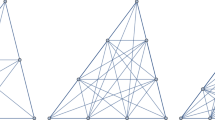Abstract
We investigate the following mesh refinement problem: Given a mesh of polygons in three-dimensional space, find a decomposition into strictly convex quadrilaterals such that the resulting mesh is conforming and satisfies prescribed local density constraints.
The conformal mesh refinement problem is shown to be feasible if and only if a certain system of linear equations over GF(2) has a solution. To improve mesh quality with respect to optimization criteria such as density, angles and regularity, we introduce a reduction to a minimum cost bidirected flow problem. However, this model is only applicable, if the mesh does not contain branching edges, that is, edges incident to more than two polygons. The general case with branchings, however, turns out to be strongly MP-hard. To enhance the mesh quality for meshes with branchings, we introduce a two-stage approach which first decomposes the whole mesh into components without branchings, and then uses minimum cost bidirected flows on the components in a second phase.
This author was supported by the special program “Efficient Algorithms for Discrete Problems and Their Applications” of the Deutsche Forschungsgemeinschaft (DFG) under grant Mo 446/2-2.
Preview
Unable to display preview. Download preview PDF.
Similar content being viewed by others
References
R. K. Ahuja, T. L. Magnanti, and J. B. Orlin, Network flows, Prentice Hall, 1993.
M. Bern and D. Eppstein, Mesh generation and optimal triangulation, Computing in Euclidean Geometry, 2nd Edition (D.-Z. Du and F. Hwang, eds.), World Scientific, Singapore, 1995, pp. 47–123.
J. R. Brauer, ed., What every engineer should know about finite element analysis, Marcel Decker Inc., 1993.
U. Derigs, Programming in networks and graphs, Lecture Notes in Economics and Mathematical Systems, vol. 300, Springer-Verlag, Berlin, 1988.
J. Edmonds, An introduction to matching, Lecture notes, University of Michigan, Ann Arbor, 1967.
K. Ho-Le, Finite element mesh generation methods: a review and classification, Computer-Aided Design 20 (1988), 27–38.
B. Joe, Quadrilateral mesh generation in polygonal regions, Computer-Aided Design 27 (1995), 209–222.
M. Mülller-Hannemann, High quality quadrilateral surface meshing without template restrictions: A new approach based on network flow techniques, to appear in Proceedings of the Sixth International Meshing Roundtable, Park City, Utah, 1997.
R. H. Möhring, M. Müller-Hannemann, and K. Weihe, Mesh refinement via bidirected flows: Modeling, complexity, and computational results, Technical report No. 520/1996, Fachbereich Mathematik, Technische Universität Berlin, 1996, to appear in the Journal of the ACM, vol. 23, no. 2, 1997.
M. Müller-Hannemann and K. Weihe, Minimum strictly convex quadrangulations of convex polygons, Proceedings of the 13th Annual ACM Symposium on Computational Geometry, Nice, France, ACM, 1997, pp. 193–202.
T. K. H. Tam and C. G. Armstrong, Finite element mesh control by integer programming, Int. J. Numer. Methods in Eng. 36 (1993), 2581–2605.
O. C. Zienkiewicz and R. L. Taylor, The finite element method, McGraw Hill, London 1989.
J. Z. Zhu, O. C. Zienkiewicz, E. Hinton, and J. Wu, A new approach to the development of automatic quadrilateral mesh generation, Int. J. Numer. Methods in Eng. 32 (1991), 849–866.
Author information
Authors and Affiliations
Editor information
Rights and permissions
Copyright information
© 1997 Springer-Verlag Berlin Heidelberg
About this paper
Cite this paper
Möhring, R.H., Müller-Hannemann, M. (1997). Complexity and modeling aspects of mesh refinement into quadrilaterals. In: Leong, H.W., Imai, H., Jain, S. (eds) Algorithms and Computation. ISAAC 1997. Lecture Notes in Computer Science, vol 1350. Springer, Berlin, Heidelberg. https://doi.org/10.1007/3-540-63890-3_29
Download citation
DOI: https://doi.org/10.1007/3-540-63890-3_29
Published:
Publisher Name: Springer, Berlin, Heidelberg
Print ISBN: 978-3-540-63890-2
Online ISBN: 978-3-540-69662-9
eBook Packages: Springer Book Archive




